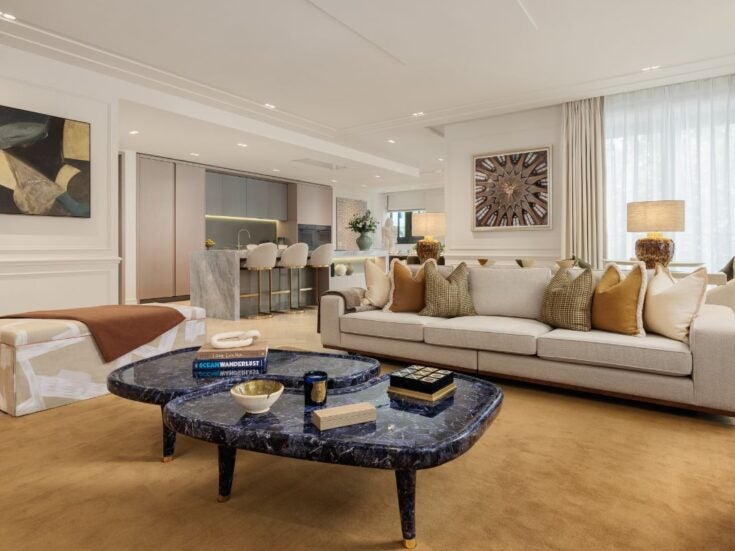
If you’ve ever thought about building your own des-res, it’s not so far from dream to drawing-board to domestic bliss any more, says Penelope Bennett
ACCORDING TO GOVERNMENT figures, house building in the UK fell to its lowest level for more than 60 years in 2009, with the number of homes completed that year representing a 17 per cent drop on the number completed in 2008. Privately shopping for an architect to build your home to your exact requirements, however, is on the up. We are seeing ten times more homes being ‘self-built’ now than we were 30 years ago (according to the National Self Build Association, or Nasba), back when just 2,000 houses a year were constructed by folk eschewing what volume house builders had to offer.
Across the country, frustration with dull, identikit, impersonal design has helped to fuel the rise in viewership figures of shows like Grand Designs — at its peak one of the most popular shows on British television — building-specific magazine readership and attendance at major national self-build exhibitions.
At the higher end of the market, the trend is taking more sophisticated shape (Grand Designs isn’t for everyone). If you want a Norfolk mill constructed using Japanese oak, a Victorian Cotswold stone farmhouse linked to its adjacent barn with huge panels of glass, or a home that achieves level six of the Code for Sustainable Homes (implementing solar thermal and PV panels and a heat recovery system that cancels the need to light the wood-burning stove throughout an extremely cold winter), and if you have the means, what is stopping you from getting it done?
So prevalent has it become for ‘Those Who Can’ to ‘Do’ that HSBC Private Bank has joined forces with the Royal Institute of British Architects (RIBA) to relaunch the leading accolade for the country’s best new house, the RIBA Manser Medal, doubling the prize money to £10,000 and giving the award its own ceremony in November. (It was formerly presented in the shadow of the RIBA Stirling Prize, on whose shortlisted buildings William Hill offers odds each year.)
Six architects are in the running for the Manser, the award created in 2001 to honour former RIBA president Michael Manser. Previous winners include Pitman Tozer Architects for the Gap House (2009) and Rogers Stirk Harbour for Oxley Woods (2008). The award’s private houses, says RIBA president Ruth Reed, give ‘shape to the pleasure, luxury and fulfilment we dream of in a home’. With HSBC Private Bank on board, she says, ‘the award is now fully equipped to inspire more great architecture in this area.’

Duncan Jackson, owner of one of the properties shortlisted for the Manser this year, commissioned relative newcomers Piercy Conner Architects to remodel the property that he and his wife share with their young child in Bawdsey, Suffolk. Piercy Conner had never done a house before accepting the project, but Jackson had worked with Stuart Piercy and Richard Conner at Grimshaw and Sir Nicholas told him, ‘They’ll put their heart and soul into it.’ Jackson took a leap of faith — because it’s about ‘nurturing’ talent as much as it is about getting talent to work for you, he says — and now he proudly owns the first house that firm of architects ever did.
ANYONE WITH THE means has the ability — the opportunity — to pioneer, says Jackson. His enthusiastic discourse marks him out as an industry man himself — he is a co-founder of Billings Jackson, a firm of practical problem-solvers working with architects and industry (designing furniture for Poltrona Frau and all the street furniture in New York, to name just two examples) to improve the quality of the built environment.
‘We take risks in business but remain conservative when it comes to the homes we live in,’ he says, stopping short of shaking his head in disbelief. His Martello Tower Y, one of 103 small, round forts built by the British army to resist potential invasion by Napoleon, is arguably the most unusual and the least conservative of the six homes on the award shortlist. Many of the towers were lost to the sea over time, demolished due to being unsafe or deliberately destroyed in training practice.
Approximately a third still stand, lying empty or derelict, used as museums or converted into homes. Jackson bought his from a farmer in 2002, following ‘many Sunday lunches to discuss the finer points of the contract’. (‘I’ll sell it to you, but you’re mad,’ were the farmer’s exact words.)
Cleaning the place up was no mean feat. Fetid water had to be dredged from the tower’s basement (it was last inhabited in 1870) and sent the first crew hired for the task running for the door after just half an hour on the job. Moreover, the tower’s protected status as a scheduled ancient monument on the At Risk register meant that official permission to refashion the site, however much new work promised to be commensurate with the former, could easily have been denied. As it turned out, English Heritage gave its approval, commending it as an exemplary conversion for the area.
From the outside the tower looks almost exactly as it used to, with all services successfully routed through existing ducts. The top floor and former gun platform, meanwhile, accommodating the kitchen and living area, has a detachable ‘oversail’ canvas roof, designed after English Heritage advisers denied outright enclosure.
The tower’s original front door — if you can call it that — remains. Small in size and positioned some 15ft above ground to deter and complicate enemy entry, it more recently also kept out any furniture Jackson and his wife may have wished to bring in (the bulk of it was brought in by crane, via the roof). The only drilling that did happen (a wall thickness of 12ft may have had something to do with it) was for two holes each 40cm in diameter, made at an angle, to let natural light into the basement, once the food store but now the bedroom.
‘Clients are now far braver with their commissions,’ says Peter Mackie, director of Property Vision, a subsidiary of HSBC Private Bank and a member of the judging panel on the Manser award. But bravery, he adds, ‘is dependent on where you are building. In certain locations it is easier to be brave. The environment, both dictated by local planning regulations and the physical location, have sizeable impacts on design and scope. For instance, building a glass house in the middle of the Scottish Highlands, although showcasing the breathtaking scenery, may not be the right design decision when the long winter nights set in.’
Mackie says that the riskiest part of private builds has always been ensuring that the architect appointed understands what you are trying to achieve and has the ability to deliver it. ‘Are they listening? Will they continue to listen throughout the process?’

James Gorst, a highly respected architect and a former RIBA external examiner, sees it thus: ‘The best clients are those who make it very clear what their brief is, and get very involved in all the design decisions, but then have the confidence to let the architect design the house, just as they would if they went to a top accountant: let them do their accounts. You wouldn’t go to Picasso and say, “That’s completely the wrong colour.”’
A CLIENT’S TRICKY nature, mind you, can almost be a boon. ‘If architects were just given money and allowed to go and design houses, I think it would be a very dispiriting and soulless experience,’ he says. ‘However difficult clients may be at times with their requests and demands, they do bring something indefinable but very important to the final product.’
Leaf House, which is in the running for the Manser, is one such remarkable completion. Its owner, an aficionado of architecture who feels strongly about interiors and architecture in space and family life, was ‘more influential in the final product than most’, says Gorst, who was commissioned for the north London build. Client and architect met when the former was producing a documentary on modern architecture and featured one of Gorst’s designs.
The client, whom Gorst says had very personal thinking on ‘materials and detailing and the way a room might be’, requested a family home offering minimal distraction from quotidian life in order to work within the house (both husband and wife work from home) without being disturbed by their two young children.
In response, Gorst designed a basement office for one spouse (lit by a large glass light flush with the pavement) and a top-floor office for the other (the leaf-patterned glass pavilion the house takes its name from); a ground floor dedicated to family life — with neat details such as doors that can close off otherwise open-plan arrangements into separate spaces — and bedrooms in between, each accessed via its own lobby, which in turn is accessed from the staircase. The lobbies act as acoustic seals between any noise the children might make in the bedroom and the rest of the house.
In this case, the client chose the architect because he liked the latter’s style. Gorst set up his own practice, James Gorst Architects, in 1981, and now focuses exclusively on original modern houses that ‘push the formal architectonic boundaries as far as we can’.
The important thing when choosing an architect is to do your research, he says, recommending that clients peruse specialist bookshops to get a notion of the kind of house that they want, then draw up a shortlist and ‘have the confidence to just contact the architect’ in question. ‘You know,’ he adds, quashing any reluctance that may be felt by the unacquainted, ‘architects are very approachable.’
It would appear that this award holds more weight this year than ever before (well done to HSBC PB for predicting this) because its aim — to identify and celebrate innovation in new house builds — is all the more attainable given the current economic climate. Builders are very keen for work right now (‘You always get the best built buildings in a recession and the worst buildings in a boom,’ remarked Gorst) as volume house builders are in virtual hibernation.
WHILE A PRIVATE build won’t single-handedly safeguard the jobs of tens of thousands of construction workers laid off since the crunch, it will harness the attention and skill of those individuals it does take on, and in theory make for a house built to higher quality standards. It will also invest in and impact on the supply chain — from architects and sub-contractors to building material and utility suppliers — potentially helping to generate a local economy at the same time as exploring new ideas in housing and construction, and deciding for yourself exactly where the walls go, rather than buying a place and then knocking them down once you’ve moved in.
It will require energy, enthusiasm and determination. But given the exponential growth in private capital, the cost of building a new home — you can build a very significant new home for £3–4 million — is easily affordable for a large number of people. Finding the right spot to build on will not be the most straightforward thing you’ll ever do — there are an estimated 6,000 plots listed in the UK at any one time with as many as 50,000 people chasing them, and in rural areas, where many would prefer to build, land availability is constrained by tight planning regulations or Green Belt restrictions. But no one ever said it would be easy. Only, for the most part, that it’s the best thing they’ve ever done, and the hassle, well, that was part and parcel of the experience. Fortune favours the brave.
As for the RIBA Manser Medal winner (to be announced on 5 November), may the best architect win. All six on the shortlist have already won a RIBA award that made them eligible for the Manser, so their work can begin to inspire the wider housing industry regardless of whether or not they win the Manser. And in any case, as they say, the reward of a thing well done is to have done it.
From top: Furzey Hall Farm in Gloucestershire (Will Pryce); Leaf House in north London (Hélène Binet); exterior of Martello Tower Y in Suffolk (Edmund Sumner)







